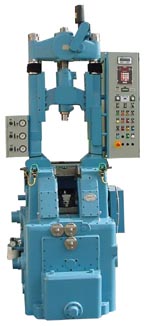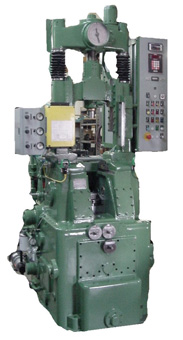|
Why buy a Remanufactured Press?
Answers to our most commonly
asked questions.
 What
is the difference in a reconditioned press and a remanufactured
one? What
is the difference in a reconditioned press and a remanufactured
one?
We sometimes are able to sell a used press as a reconditioned unit
if it is in good condition when we obtain it. The press is still
partially or completely disassembled and parts replaced as
necessary. All motions are brought into spec and the housing is
sealed and painted.
These presses many times are a very good value. The downside is
that most of the presses we obtain are not in good enough
condition, and must be remanufactured.
Remanufactured presses have long been the specialty of Precision
Compacting Technologies, Inc. We have a description of what is
done to each model available if you request it, but in short, we
replace or re-machine everything to return the press back to as
new condition. You can expect new press performance and longevity,
plus up to one years warranty.
Why are good used DORST and new ATLAS
presses so expensive?
These presses feature heavy cast housings and enclosed gear boxes
that are internally lubricated. Their value lies in the fact they
are much more accurate and last longer than welded frame presses.
Many welded frame presses use rods to transmit force for ejection
from the main drive, providing substantially less available
ejection force.
Because these cast housing presses last longer, and are capable of
higher speed and accuracy, the overall cost of production per part
is usually less than that of a much cheaper machine!
Combine this with the fact that they will make parts that
literally could not be made on a welded frame machine, and you can
understand their value. We have sold machines to customers
who have completely eliminated second operation machining because
they were able to hold part height within .001 inch in pressing.
I guess the best way to sum this up is to apply the old adage "You
get what you pay for".
Why canít my company rebuild our own
presses and save money?
This is one of our most frequently asked questions. We would be
not only arrogant, but stupid, to answer this with anything other
than "you can"... but at what cost?
The problem is that not only are these presses very complex
mechanically, but no two are exactly alike.
The reason for this is that unlike most cars or machine tools such
as a lathe or milling machine, they were never mass produced in
sufficient quantity to be able produce "bolt on and work" standard
parts. Also, after being rebuilt, many shafts and journals will be
slightly undersized requiring fitting of undersize bearings.
The hardest thing in a remanufacture is to restore standard
motions and accuracy to the press. Over the years we have
developed hundreds of special tools, fixtures, and documented
procedures to insure consistent quality in our remanufactured
presses. We have, along with our sister company in Germany,
successfully remanufactured over 650 DORST presses over the last
18 years.
 One
example of "a rebuild gone bad" we have seen the results of many
times is the failure to properly fit the prepress wedge on a DORST
toggle press. Without getting into the full workings of this
type of machine, let me explain that this wedge sits in the center
of the press main traverse, which, at the bottom of the pressing
stroke, pushes the wedge forward and transforms this movement into
prepress motion. The wedge rests on a pillar attached to the
housing with the top of it contacting the lower side of the main
traverse. One
example of "a rebuild gone bad" we have seen the results of many
times is the failure to properly fit the prepress wedge on a DORST
toggle press. Without getting into the full workings of this
type of machine, let me explain that this wedge sits in the center
of the press main traverse, which, at the bottom of the pressing
stroke, pushes the wedge forward and transforms this movement into
prepress motion. The wedge rests on a pillar attached to the
housing with the top of it contacting the lower side of the main
traverse.
The problem occurs when someone attempts to rebuild the machine
and does not properly fit the wedge to its mating parts. If
perfect angular alignment is not achieved and the wedge is
captured instead of being propelled forward, full tonnage is
applied to it locking up the press, and many times breaking the
main housing. Even if a cautious mechanic decides to leave
this area alone and put in new bushings and bearings, this
relationship will be altered ,with the same results possible.
What is the advantage of a new electrical
panel ?
Safety, and enhanced control over process are the main reasons for
updating to a modern control system. The great thing about modern
control systems is that they can enhance the performance of these
excellent old presses to rival anything built today, paying for
themselves in savings in broken tools and increased production
rates very quickly.
Why do I need a Digital Tonnage Monitor?
This is one of the most useful and money saving options that you
can add to your press. If set up properly, it saves tooling,
protects the press from damage and provides valuable information
in real time that may be recorded. But not all tonnage
monitors are created equal, most of the units available are not
fast enough or accurate enough as installed to give satisfactory
service on a compacting press. The ability to read an out of
normal press curve pressure spike before press position at less
than maximum peak pressure is what you need to save tools.
What is a Programmable Limit Switch?
The Programmable Limit Switch breaks the pressing cycle up into
360 degrees allowing the user to turn systems on and off during
the pressing cycle as needed. These systems would include, but are
not limited to, top punch hold down, dwell time, light curtain
muting, pick off devices, and interfacing with the tonnage monitor
for early tonnage warning.
What is a Triple Microprocessor Clutch
Control?
This unit features three identical microprocessor boards reading
the same information for redundancy. It also monitors the
braking speed of the press and alerts the operator in case of
brake wear or failure.
|